edWeb 2024 Survey: Impact of Staffing Shortages on Special Needs Students
edWeb.net, in partnership with Stages Learning, has published the results of the second annual survey on the “Impact of Staffing Shortages on Special Needs Students.” The survey is designed to get quantitative and qualitative feedback from edWeb members on the impact of teacher and paraprofessional staff shortages, the professional learning support that is being provided, and strategies that may help to alleviate the staffing shortages.
The 2024 survey was emailed to 62,476 edWeb members with a role or interest in special education. We received 742 responses, a 1.1% response rate, with no incentive. This is directly comparable to last year’s deployment. Here is a demographic profile of the respondents. In addition to the quantitative results, we received over 500 comments providing in-depth insights and many ideas.
Quantitative Results
The first question asked about the current state of the staffing shortage for teachers and paraprofessionals who teach and work with special needs students. The results for last year and this year are very similar, as are the results for the two positions, with most respondents reporting that both positions are understaffed.
Next we asked how the staffing situation compares to previous periods. In January 2023, we asked how the situation compared to pre-COVID, and this year we asked how the current situation compares to last year. Most respondents reported that it is about the same. The situation may be not quite as bad, but these positions continue to be severely understaffed.
We asked respondents how teachers and paraprofessionals are supported by a variety of professional learning methods, and they reported that teachers and paraprofessionals are not “very supported” by any of these options. Paraprofessionals are, for the most part, “not supported” by any of these professional learning options.
We asked respondents what type of professional learning is most effective, and it’s not surprising that coaching and mentorship, and in-person professional learning are rated most helpful. Other forms of professional learning that are often easier to provide are helpful, and providing webinars and professional learning communities for teachers and paraprofessionals are easy ways to provide more learning opportunities and support.
We asked respondents about any practices they’ve seen that are effective in ameliorating staffing shortages. Higher compensation and better working conditions lead the list, following by support for new teachers. 25% of the respondents said they had not seen any of these practices in place, or effective.
Survey Comments:
We received 500 comments from respondents (52 pages printed), reflecting the depth of their concerns about the staffing issues. We used ChatGPT to summarize the comments which resulted in the following summary:
Given the length and depth of the responses, it’s clear that there are significant challenges faced in special education, particularly related to staffing and resource availability. Here is a summarized version of the major points:
1. Staffing Shortages: There’s a critical need for more special education teachers and paraprofessionals. The shortage leads to larger class sizes, less individual attention, and inadequate support for students with special needs.
2. Professional Development: Both teachers and paraprofessionals require more targeted training to meet the diverse needs of special education students effectively.
3. Compensation and Working Conditions: Many comments suggest that improved pay and benefits, as well as a balanced workload, could help attract and retain qualified special education staff.
4. Diverse Student Needs: There’s a wide range of special needs among students, including behavioral, emotional, and academic challenges, that require more resources and individualized approaches.
5. Administrative Support: There’s a call for better support and understanding from administrators, particularly regarding the complexities of special education.
6. Resource Allocation: Educators express the need for better allocation of resources, such as assistive technologies and materials tailored to special education.
7. Inclusion and Integration: Challenges with effectively integrating special education students into general education settings were mentioned, as well as the need for adaptation in teaching methods.
8. IEP Implementation: Meeting the individualized education program (IEP) goals for each student is made difficult due to staffing shortages and time constraints.
9. Educational Pathways: Concerns were raised about alternate certification pathways and the need for a more robust training system for special education professionals.
10. Parental and Community Support: Enhanced engagement and understanding from parents and the community could improve the special education environment.
11. Emotional and Mental Health: The emotional and mental health of students and educators alike are strained due to the high demands and challenging work environment.
12. Recognition and Respect: A sentiment for greater recognition and respect for the demanding work that special education entails was evident.
13. Legal and Bureaucratic Pressures: Educators feel burdened by the legal and administrative aspects of special education, which can detract from teaching time.
14. Work-Life Balance: The difficulty in achieving a work-life balance due to the demands of the profession is leading to burnout and turnover.
15. Student Progress and Outcomes: The lack of resources and support is impacting student progress, with many not receiving the services they require to succeed.
In essence, the comments highlight a special education system under strain, with passionate educators calling for systemic changes to better support students and staff. The need for more resources, better training, fair compensation, and a supportive work environment are consistent themes.
ChatGPT does a great job summarizing the major issues. Reading all of the 500 comments conveys more depth of feeling from educators describing a system tragically under strain and in crisis. The quality of teaching and para support is declining, in addition to the staffing shortages, and there are more students with IEPs and IEPs that identify more needs.
Here are some examples of a few out of many in-depth comments we received:
Many of our special education, middle school aged students do not have the basic skills they will need to be able to be successful, independent, functional adults. They struggle with basic math skills, writing skills and the ability to read. In our class we work on these skills on a daily basis, but they need more time, more individual assistance, and websites that will allow them to learn but at the same time work independently when there is no one available to work with them at a particular time because they are working with another student who needs more assistance than others (for example, the site will read everything for them if needed). Our students are fortunate that they have the chance to interact with other people outside of our classroom in public because we have a small mini mart we which allows us to earn field trips. However, they still need more opportunities out in public to see and learn to deal with everyday situations, whether positive or negative. These opportunities encourage and teach them about social skills and how to use these skills with others. But, it still is not enough. Many special education students have experienced major traumas in their lives and they need more personal socialization opportunities as well as being able to give them the chance just to talk about whatever is on their minds without having to jeopardize the much needed time to learn basic skills also. One thing I feel ‘regular’ educators need to incorporate more in their classroom is adaptation. So many teachers have a particular teaching style that they tend to stick with year after year. Each child, whether they have special needs or not, should have the opportunity to have their lessons and tests given to them in a way that highlights their strengths. If it means giving an oral test-then so be it, for example. Everyone learns differently and special education students should have the right to be able to shine in their own way also.
I am happy to see that there are alternate pathways into the field of education. However, I believe this is negatively impacting our students with special needs. As an Instructional Coach over the last 5 years, I have been charged with mentoring and coaching our new teachers – including our alternate pathway to certification teachers. What I have noticed is that in the general education field, these teachers usually do okay because they have others in the building to lean on and learn from. Our special education teachers, though, do not have this support as many times they are the only one doing what they are doing in the building. They are not aware of all the instructional strategies, accommodations, assistive technology, or alternate curriculum that are required for students with special needs. They are not being trained to support this. In addition, paperwork involved (and legal obligations) are not adequately taught therefore many times veteran special education teachers or the department heads are left dealing with either fixing mistakes or doing the work for the teacher because it has to be done correctly. I think that there has to be a better way to get teachers to go into the field of special education in higher education rather than allowing for alternative routes to certification in this most critical area.
It’s very much survival on many days. With many unfilled para positions, students that require more 1:1 intervention are now getting grouped with others and learning suffers. There are so many other professionals out there seeking employment who could fill those gaps if we (as an educational system) would allow ourselves to think outside the box. For example, a certified occupational therapy assistant could be hired to be part of an intensive classroom team… not as a para, but as a part of the team to guide work toward functional skills. The models for best practice for “self-contained” low incidence types of rooms indicates an interdisciplinary model of collaborative problem solving and we never get there because we are still pulling students out for related services and are working under caseloads that won’t allow more push-in to those rooms. We will lose our low incidence teachers if we don’t support them better.
Our students with special needs require that we bring our all everyday so that they can receive the best education that we can provide for them. However, while giving our all every single day, our cups run on empty if they are not filled back up. We need more time to plan and create the activities that will best address the needs of our students. We serve an exceptional group of students who all have individual needs and needs for individual approaches to the same content in order to be able to access this content in a way that helps them to master it. If we are able to bring to the table curriculum that inspires and teaches our students in a way they understand, you can see their whole face and posture light up with understanding that was not there when presented the same material in a way that did not benefit them. This spark is why we teach, but many opportunities to light up the minds and hearts of our students are lost when we do not have sufficient time to create the material needed to teach our students to grow and develop understanding. We need time to be our best so our students can achieve their best. This fills my cup, seeing success not only with my students, but in my life as well. I want us to thrive together.
Lisa Schmucki, founder and CEO of edWeb, presented a summary of the survey results on an edWebinar with Stages Learning. You can view the video of the presentation here.
We’re happy to provide all of the survey comments to policy and research organizations who would like to study this in greater depth. There is so much information and many ideas contained in the comments we received.
For more information and questions on the survey, contact [email protected].


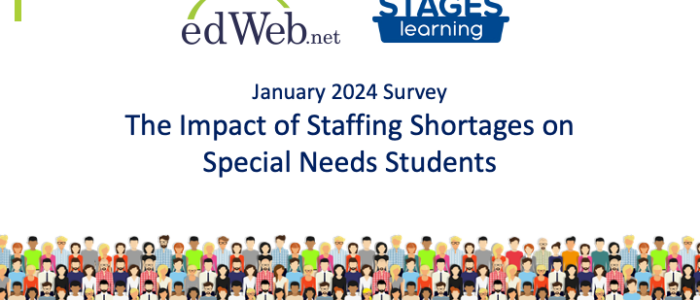



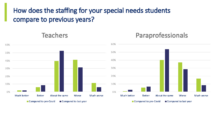
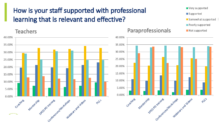
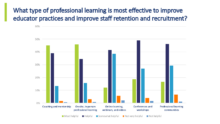
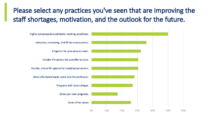
Comments are closed.